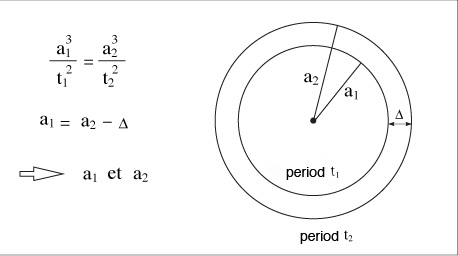
The third law, the Law of Harmonies, relates the period of a planet's orbit, T, to the length of its average radius. It states that the square of the period of the orbit T is proportional to the cube of the radius r, and that every planet around the same Sun has the same constant of proportionality.

The proof begins with dA/dt = l/(2 m), the expression to represent the area swept out by the radius of the planet's orbit.
Multiply both sides by dt to get dA = [l/(2 m)] dt.
This can be integrated to get an expression relating the total area of the orbit to the period of the orbit:
A = [l/(2 m)] T.
Square both sides and solve for T^2:
T^2 = 4 (m2/l2) A^2.
The area A of an ellipse is pi a b, where a is the length of the semimajor axis and b the length of the semiminor axis. Thus our expression of T^2 becomes:
T^2 = 4 pi^2 (m2/l2) a^2 b^2.
b is related to a and c, the distance between the focus and the center, by a2 = b2 + c2,
so b^2 = a^2 - c^2: T2 = 4 pi^2 (m^2/l^2) a^2 (a^2 - c^2).
Since c = a e, we find that
T^2 = 4 pi^2 (m^2/l^2) a^2 (a^2 - a^2 e^2)
T^2 = 4 pi^2 (m^2/l^2) a^2 [a^2 (1 - e^2)]
T^2 = 4 pi^2 (m^2/l^2) a^4 (1 - e^2).
Then, a property of ellipse geometry is used which indicates that e p = a (1 - e2).
Factor out a (1 - e^2) from our expression of T^2 and replace it with e p . |
T^2 = 4 pi^2 (m^2/l^2) a^3 (e p).
| T2 is proportional to a3. Kepler's first law shows that e p = l2/(G m2 M). Substitute this into our expression for T^2 to find that T^2 = 4 pi^2 (m^2/l^2) l^2/(G m^2 M) a^3.
|
The above proof is adapted from:
"Francis, Erik M. "Kepler's Laws: Kepler's Third Law." Kepler's Laws: Kepler's Third Law. Alcyone Systems, 2015. Web. 22 Apr. 2015. <http://www.alcyone.com/max/physics/kepler/6.html>."
"The Apple, the Moon, and the Inverse Square Law." The Physics Classroom. N.p., n.d. Web. 22 Apr. 2015. <http://www.physicsclassroom.com/class/circles/Lesson-3/The-Apple,-the-Moon,-and-the-Inverse-Square-Law>.
No comments:
Post a Comment